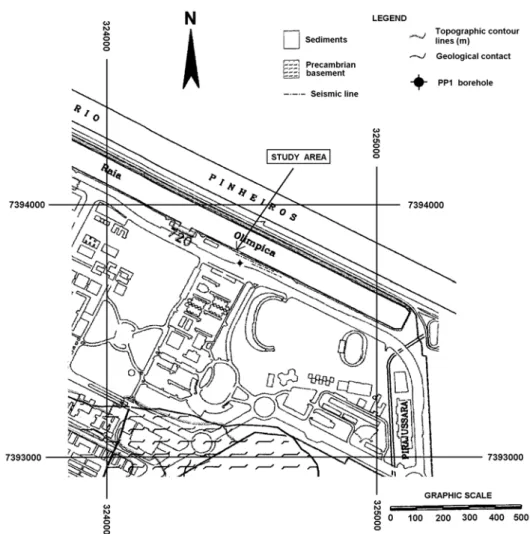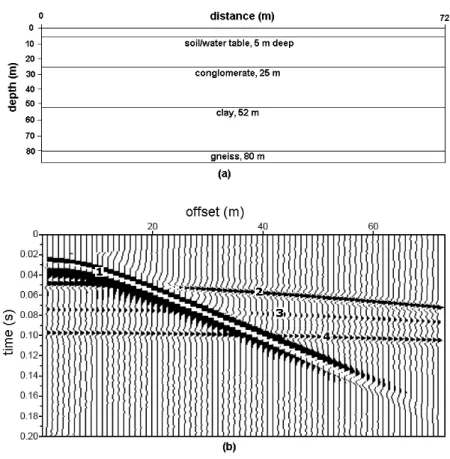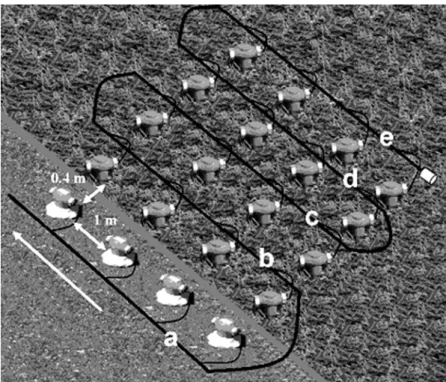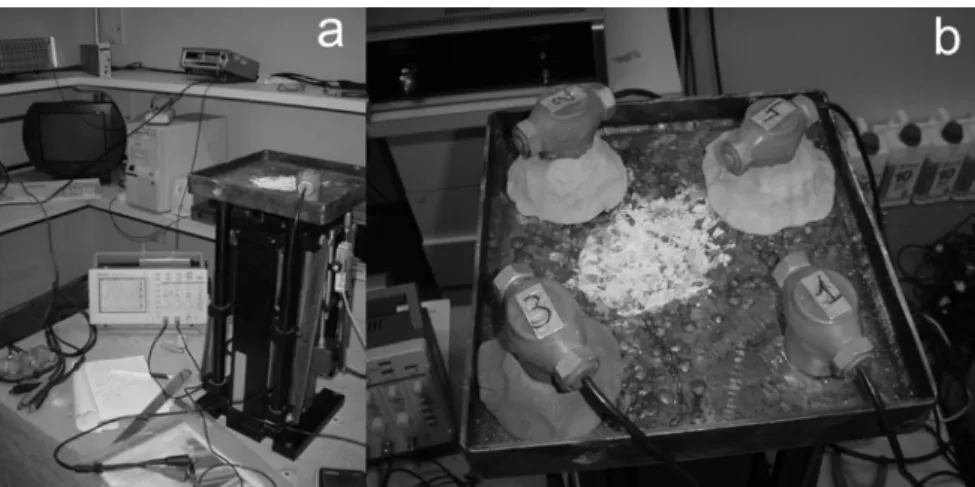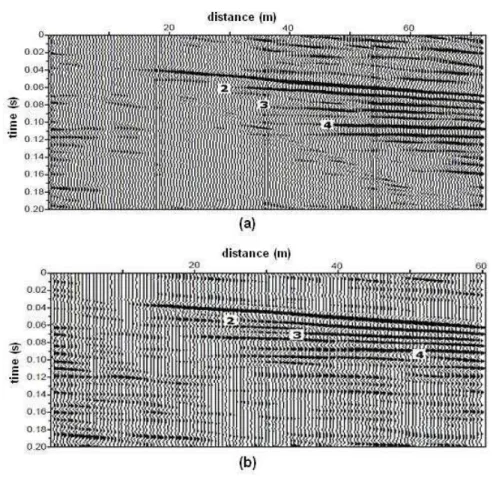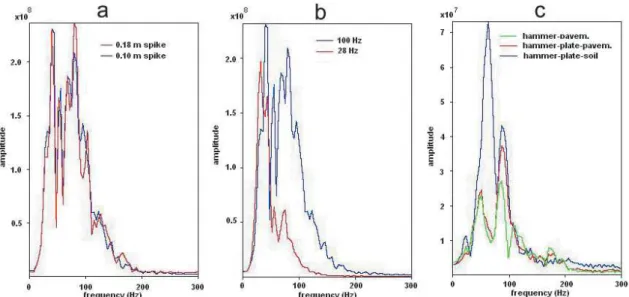www.scielo.br/rbg
COMPARATIVE TESTS OF SEISMIC SOURCES AND GEOPHONES AIMING AT SHALLOW
REFLECTION SEISMIC INVESTIGATION IN URBAN AREAS
Oleg Bhokonok
1, Renato Luiz Prado
2and Liliana Alcazar Diogo
3Recebido em 24 outubro, 2005 / Aceito em 23 fevereiro, 2006 Received on October 24, 2005 / Accepted on February 23, 2006
ABSTRACT.Pseudo walkaway noise tests were accomplished in study area in S˜ao Paulo city, Brazil, in order to evaluate the potentiality of seismic reflection technique in shallow geological/geotechnical investigation in urban environment, where there is usually the presence of different types as well as intensities of noises and the paved surface. Data acquisition was conducted with a 24 channel seismograph with 24 bit A/D converter, 28 Hz and 100 Hz geophones, as well as sledge hammer and seismic rifle as sources. The best results were obtained with: (i) 100 Hz geophones with 0.18 m spike and hammer source with steel plate; (ii) 100 Hz geophones coupled through clay on asphaltic coverage with hammer source applied on asphalt. Laboratory tests were also accomplished in shake table in order to evaluate geophone responses when they were coupled with different types of clay. Tests indicated clay employment is a good alternative to couple geophones, notwithstanding kaolinitic clays are less indicated.
Keywords: seismic reflection, seismic sources, shallow geophysics, geophones, seismic in S˜ao Paulo city.
RESUMO.Visando avaliar a potencialidade do emprego da s´ısmica de reflex˜ao na investigac¸˜ao geol´ogico-geot´ecnica rasa em ambientes urbanos, nos quais nor-malmente h´a a presenc¸a de ru´ıdos de diferentes tipos e intensidades, assim como de superf´ıcies pavimentadas, foram realizados diversos ensaios de an´alise de ru´ıdos (pseudo walkaway noise test) em uma ´area teste na cidade de S˜ao Paulo, Brasil. Na aquisic¸˜ao dos dados foram empregados um sism´ografo de 24 canais com conversor A/D de 24 bit, geofones de 28 Hz e 100 Hz e fontes s´ısmicas do tipo marreta e rifle s´ısmico. Os melhores resultados foram obtidos com: (i) geofones de 100 Hz com ponteira de 0,18 m e fonte marreta com placa de metal; (ii) geofones de 100 Hz acoplados atrav´es de argila na cobertura asf´altica com fonte marreta aplicada sobre asfalto. Tamb´em foram realizados ensaios de laborat´orio em mesa vibrat´oria para avaliar as respostas dos geofones quando acoplados com diferentes tipos de argila. Os testes indicaram que o emprego de argilas ´e uma boa alternativa para acoplar os geofones, sendo as argilas caulin´ıticas as menos indicadas.
Palavras-chave: s´ısmica de reflex˜ao rasa, geofones, fontes s´ısmicas, geologia da cidade de S˜ao Paulo.
1Graduate Program, Instituto de Astronomia, Geof´ısica e Ciˆencias Atmosf´ericas, Universidade de S˜ao Paulo, Rua do Mat˜ao, 1226, 05508-090 Cidade Universit´aria, S˜ao Paulo, SP, Brasil. Phone: (11) 3091-2762; Fax: (11) 3091-5034 – E-mail: oleg@iag.usp.br
2Instituto de Astronomia, Geof´ısica e Ciˆencias Atmosf´ericas, Universidade de S˜ao Paulo, Rua do Mat˜ao, 1226, 05508-090 Cidade Universit´aria, S˜ao Paulo, SP, Brasil. Phone: (11) 3091-2762; Fax: (11) 3091-5034 – E-mail: renato@iag.usp.br
82
SHALLOW SEISMIC IN URBAN AREASINTRODUCTION
Since the 1990s in great Brazilian urban centres, an expressive in-crease of civil works focused in infrastructure needs is happening, and, following a worldwide tendency, they have been concentrated in underground infrastructure and facilities such as road tunnels, overflow retention reservoirs, pipelines, power lines, etc.
Aiming at elaborating design-build projects and executing the previously mentioned works a good geological knowledge is ne-cessary such as spatial distribution of geological strata and thick-nesses, as well as recognition and positioning of geological struc-tures.
In this context, shallow seismic reflection presents a great application potential, once it allows mapping structures continu-ously, interpolating subsurface geological information obtained from drilling at discrete locations (Hunter et al., 1984; Jeng, 1995; Steeples & Miller, 1990).
However, urban environment presents several aspects that damage or hamper the acquisition as well as the analysis of seismic data, as restricted operation space and altered superfi-cial strata (earth embankments and asphaltic coverage), likewise background noise associated to power lines and shake noise from the traffic.
Those factors are contributed so that seismic reflection does not be considered yet an effective investigative method for buil-ding practitioners in Brazilian urban centres. (Prado et al., 2001). In order to investigate the accuracy and potentiality of shal-low seismic reflection method in the described conditions, seve-ral pseudo walkaway noise tests were accomplished in a densely occupied area of S˜ao Paulo city. Another assay was also accom-plished as comparative tests in controlled laboratory conditions for evaluating the spectral content of seismic signal by using clay in geophone coupling.
Results of acquisition, carried out with different types of geo-phones and sources, as well coupling conditions are presented.
We discuss the results of comparative tests among geopho-nes of different frequencies and plant in soils and on asphaltic coverage through spikes and clay. Geophone responses obtained from tests in shake table are also discussed.
LOCATION AND GEOLOGICAL CONTEXT OF STUDY AREA
The study area is located in Western S˜ao Paulo city, in the left margin of Pinheiros River (Figure 1). The choice of this place was conditioned by several factors: i) existence of geological infor-mation from nearby boreholes; ii) possibility to do simultaneous acquisition on asphaltic coverage and soil; iii) to be placed in a
typical urban space, with heavy traffic of vehicles and people. The geology of this area consists of tertiary sediments of Itaquaquecetuba Formation from S˜ao Paulo Sedimentary Basin, which settles on Precambrian basement. PP1 well description lo-cated close the acquisition area provides the following information about main lithofacies: (1) sands until 25 m depth; (2) conglome-rate from 25 m to 35m; (3) sands from 35 m to 52 m; (4) clays from 52 m to 80 m; (5) granite-gneisse basement.
METHODOLOGY
Initially, 1D geological model was obtained, analysing information from PP1 well (Figure 2a); synthetic seismograms were generated from this model by using Triseis algorithm of Seismic Unix soft-ware (Stockwell & Cohen, 1998) in order to estimate the reflection travel time from the interfaces (Figure 2b).
Following, several pseudo walkaway tests were executed. The tests were made using 28 Hz and 100 Hz geophones, both coupled to soil with spikes of 0.1 m and 0.18 m length, and fixed with clay in paved area (Figures 3a, 3b). On soil, two types of sources were used: (1) 12-caliber rifle (Figure 3d), fired in holes of approxima-tely 0.4 m deep; (2) sledge hammer of 6 Kg (Figure 3c) impacted on steel plate. Hammer was used on pavement with impacts on plate and directly on asphalt. Table 1 presents parameters and geometry employed in these tests.
Table 1– Pseudo walkaway tests acquisition parameters.
Number of chanels 24
Minimum offset 0,5 m
Maximum offset 72 m
Receiver spacing 0,5 Geophone type 28 Hz and 100 Hz
Source type 12-caliber rifle and Sledgehammer - 6 Kg Coupling Spike (0,10 m and 0,18 m), Kaolinitic clay
Sample rate 0,25 ms
Recording time 200 ms Pre A/D low cut filter 3 Hz
The main objective of these field tests was to compare res-ponses of different geophones, in different coupling situations and with wave generation of several seismic sources, and starting from this study finding to establish equipment and ideal parameters to improve the quality and resolution of shallow seismic reflection.
The comparative study was based on the analysis of ampli-tude spectra obtained by different test conditions, as well as on final results of seismogram processing.
envi-Figure 1– Site map showing seismic test line, wells and local geology (adapted from Iritani, 1993).
ronment in which geophone parameters (frequency and coupling) were tested simultaneously by the same energy generation. For that, a walkaway test was made with five parallel linear arrays, with 0.4 m equidistant one each other, and 4 geophones each one (1 m spacing). All arrays were connected to the same seismic cable and acquisition system. New records were acquired with variations of sources, geophones and coupling, concurrently, with minimum offsets of 20, 40 and 60 meters (Figure 4).
Besides field tests, tests with geophones were also done un-der controlled laboratory conditions, in orun-der to evaluate their res-ponses using different clay mineral for coupling.
The experiment (Figure 5) was constituted by APS Dynamics Inc shake table (APS Electro-six model) positioned at a mas-sive block of concrete, Entelbra audio generator (ETB511 model), APS Dynamics Inc Power Amplifier signal amplifier (124 mo-del), OYO seismograph (DAS-1 momo-del), Tectronix oscilloscope
(TDS220 model), four 100 Hz geophones, and three different clay samples (Table 2). A tray, specifically projected for this experi-ment, was fixed to shake table. This tray allowed fixing rigidly one of the four geophones, along with reproducing a similar surface of paved area via small rugosities (Figure 6).
84
SHALLOW SEISMIC IN URBAN AREASFigure 2– (a) Geological model generated from PP1 log; (b) synthetic seismogram generated from the geological model. Event 1: interface soil/water table, 5 m of depth, Vint= 0.4 km/s (interval velocity); event 2: top of conglomerate, 25 m of depth, Vint= 1.7 km/s; event 3: top of clay, 52 m of depth, Vint= 2.1 km/s; event 4: basement, 80 m of depth, Vint= 2.4 km/s.
iv) simultaneous records were made with oscilloscope and seis-mograph.
The same clay samples were submitted to mineralogical analysis by X-Ray difratometry (Table 2). Results indicated the clay from 01-Sample was predominantly kaolinitic (90-95%) dif-ferently to the two other ones that contained a considerable amount of smectite and illite (up to 55%).
Table 2– Mineralogical Analysis of clay samples originated from X rays difratometry.
Sample Clay mineral Semiquantification (%) Kaolinite 90 – 95 Sample 01 Illite 3 – 5
Smectite <2 Kaolinite 50 Sample 02 Smectite 35 – 40
Illite 10 – 15 Kaolinite 60 – 65 Sample 03 Illite 20 – 25 Smectite <15
An analysis was also made to establish the moisture content of these samples. The moisture content was determined as the rate between water weight and dry solid material weight expres-sed in percentage. Results are presented in Table 3. It is possi-ble to observe the found contents were relatively similar, although the largest value (24%) was associated to more kaolinitic sample (01-Sample).
Table 3– Moisture content of clay samples.
Sample Moisture content (%) Sample 01 24,64 Sample 02 19,25 Sample 03 23,30
RESULTS
Figure 3– (a) Geophones with spikes of 0.1m and 0.18m (b) geophones coupled through clay; (c) sledge hammer of 6 Kg; (d) 12’ seismic rifle.
86
SHALLOW SEISMIC IN URBAN AREASFigure 5– Design of shake table test: (a) APS Dynamics Inc. shake table (APS Electro-six model); (b) massive block of concrete; (c) Entelbra audio generator (ETB511 Model); (d) APS Dynamics Inc. Power Amplifier signal amplifier (124 model); (e) OYO-1 seismograph; (f) Tectronix oscilloscope (TDS220 Model); (g) four 100 Hz geophones; (h) geophone “tray”.
Figure 6– (a) Geophone rigidly fixed to table and submitted to shake signal; (b) 01-geophone used as reference of an ideal coupling (rigidly fixed to the table), and the other ones coupled with 3 different clay samples. 02-geophone coupled by using 01-Sample, 03-geophone by using 02-Sample, and 04-geophone by using 03-Sample.
Processing challenge was to preserve the high frequency con-tents and to enhance shallow reflections from “noisy” events such as direct wave, refractions, ground roll, and airwave.
Initially passband frequency filters were applied. Several bandwidth and different slopes were tested, with no satisfactory results to an increase in signal/ noise ratio.
F-k filter was applied in order to eliminate events associated to ground roll and airwave, taking care to extend the fan reject zone to spectrum part associated to spatial aliasing of airwave.
Finally, applying an AGC gain, final seismogram was obtai-ned, presenting three evident reflection events in 50 milliseconds, relative to the top of conglomerate; 75 ms, associated to the top of clay; and 100 ms, related to the basement (Figure 7).
Figure 8 presents responses of four geophones that were
fi-xed to the shake table and simultaneously submitted to an input signal programmed by audio generator. As suggested by data, all responses are equivalent. It can be also observed in Figure 8b – generated from oscilloscope measurements – and in Figure 8c – generated from traces recorded in seismograph – 01-geophone, with ideal coupling, has a frequency distribution similar to three geophones coupled to different clays. However, the record ob-tained with 02-geophone (red line), coupled predominantly with kaolinitic clay (01-Sample), presents a decrease of energy.
CONCLUSIONS
Figure 7– (a) Seismogram recorded with 100 Hz geophones coupled through spikes of 0.18 m on soil by using sledge hammer impacted on steel plate; (b) record obtained with 100 Hz geophones coupled through clay on asphal-tic pavement by using hammer impacted on steel plate. The events interpreted starting from the analysis of syntheasphal-tic seismogram generated since the description of PP1 well (Figure 2). Event 2: top of conglomerate, 25 m of depth, Vint = 1.7 km/s; event 3: top of clay, 52 m of depth, Vint= 2.1 km/s; event 4: basement, 90 m of depth, Vint= 2.4 km/s.
(i) 100 Hz geophones with spike of 0.18 m, and hammer source with steel plate; (ii) 100 Hz geophones coupled through clay on asphaltic coverage with hammer source applied on asphalt.
Analyses of amplitude spectra for the second field experiment indicated: (1) increase of length spike (from 0.10 m to 0.18 m) did not improve the signal/ noise ratio (Figure 9a); (2) 100 Hz geophones coupled through clay on pavement achieved an equi-valent result to geophones coupled with spikes on soil, since their amplitude spectra were analogous (Figure 9c); (3) 100 Hz geophone had its higher energy response in band of frequen-cies from 30 Hz up to 120 Hz, differently to 28 Hz geophone that showed an accentuated fall in its spectrum of approximately 20 db between predominant frequency (∼20 Hz), and the highest
fre-quencies (>60Hz), which explains the worst quality of acquired
data by using 28 Hz geophones (Figure 9b); (4) results obtained with hammer applied on pavement and in plate on pavement were
88
SHALLOW SEISMIC IN URBAN AREASFigure 8– Spectra obtained from records in comparative experimental tests in laboratory: a) responses of 01, 02, 03, 04-geophones rigidly fixed to table, and simultaneously submitted to the same shake signal; b) responses of 02, 03, 04-04-geophones coupled through clay, and of 01-geophone with ideal coupling measured directly in oscilloscope; c) responses of 02, 03, 04-geophones coupled through clay, and of 01-geophone with ideal coupling recorded in seismograph.
ACKNOWLEDGMENTS
The authors would like to thanks CNPq (Conselho Nacional de Pesquisa, Brasil). We are also grateful for comments from two anonymous reviewers that helped clarify the manuscript.
REFERENCES
HUNTER JA, PULLAN SE, BURNS RA, GAGNE RM & GOOD RL. 1984. Shallow seismic reflection mapping of the overburden-bedrock interface with the engineering seismograph – some simple techniques. Geophy-sics, 49: 1381–1385.
IRITANI MA. 1993. Potencial Hidrogeol´ogico da Cidade Universit´aria de S˜ao Paulo. S˜ao Paulo, SP. 97 p. Dissertac¸˜ao de Mestrado (Geociˆencias). IGc-USP.
JENG Y. 1995. Shallow seismic investigation of a site with poor reflection
quality. Geophysics, 60: 1725–1726.
PRADO RL, MALAGUTTI FILHO W & DOURADO JC. 2001. The use of shallow seismic reflection technique in near surface exploration of urban sites: an evaluation in the city of S˜ao Paulo, Brasil. Brazilian Journal of Geophysics, 19(3): 293–302.
STOCKWELL JW & COHEN JK. 1998. The New SU (Seismic Unix) User’s Manual. CWP – Colorado School of Mines, USA, version 2.2.
STEEPLES DW & MILLER RD. 1990. Seismic reflection methods applied to engineering, environmental and groundwater problems, in WARD S., Ed., Geotechnical and Environmental Geophysics, Volume I: Review and Tutorial: Soc. Expl. Geophys., 1–30.
SOUZA-SANTOS P. 1989. Ciˆencia e tecnologia de argilas. S˜ao Paulo, EDUSP, 1089 pp.
NOTES ABOUT THE AUTHORS
Oleg Bhokonok.He obtained his B.Sc in Geology from Kharkiv National University, Ukraine (1999) and his MSc in Geophysics from S˜ao Paulo University, IAG/USP, Brazil, 2005. Currently he is working at Grant Geophysical Int. His current interests include seismic methods (processing and acquisition).
Renato Luiz Prado.He obtained his B.Sc in Geology from S˜ao Paulo University, USP, Brazil (1982), his MSc in Geophysics (IAG/USP, 1994) and Ph.D. in Geosciences and Environment from S˜ao Paulo State University, UNESP (2001). From 1982 to 2001 he was employed as Researcher at Institute for Technological Researches, IPT, Brazil. In 2001, he joined the faculty at geophysical department of S˜ao Paulo University. His primary research interests include seismic methods and GPR.

